
views
X
Research source
Instead of buying a bagged mix, you can try making your own cement by obtaining and burning limestone. Also, in an emergency, you can make what’s known as “survival cement” -- although it should really be "survival concrete" -- by combining mud and grass.
Making Your Own Cement Mix
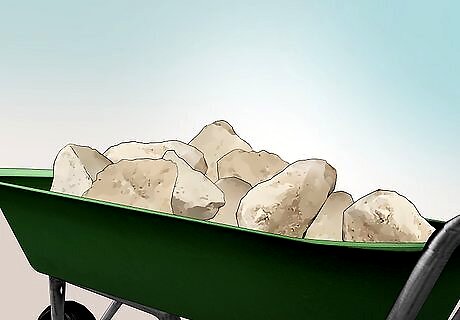
Purchase or collect limestone. If you live near a riverbed or other area where limestone is prevalent, you may be able to find limestone naturally. If not, you’ll need to purchase limestone. It can typically be found at landscaping supply stores, and may be available at large plant nurseries or garden centers. If you’re unsure whether or not the rock that you’ve collected is limestone, use a coin to scratch the surface of the rock. Limestone is soft and can be scored by the edge of a coin.

Break the limestone into small pieces. Take sturdy shovel and stab it into the limestone in order to fracture the rock and break it apart. You’ll be heating the rock in a kiln for an extended period of time, and the smaller you can break up the chunks of rock, the less time you’ll have to heat them. Aim to break the limestone into pieces not larger than 2 inches (5.1 cm) across.
Cook the limestone in a kiln or outdoor oven. In order to ready the limestone for use in cement, place it in a kiln or outdoor wood oven. Turn the kiln up to 900 °C (1,650 °F), and leave the limestone to “bake” for 4 or 5 hours. Always wear thick work gloves when working with a kiln. The gloves will also be useful when you’re pulling the baked lime back out of the kiln, since it could severely burn your skin.

Let the baked limestone cool. After the 4 or 5 hours have passed, pull the baked limestone out of the oven or kiln. Set it nearby and let the chunks cool off before you touch them. Be careful not to breathe in fumes from the baked limestone, as they are caustic and could damage your lungs. The baked limestone is called quicklime. Consider wearing some kind of respirator when pulling the quicklime out of the kiln. Quicklime is harmful to the body, and even breathing in its dust can harm your lungs.
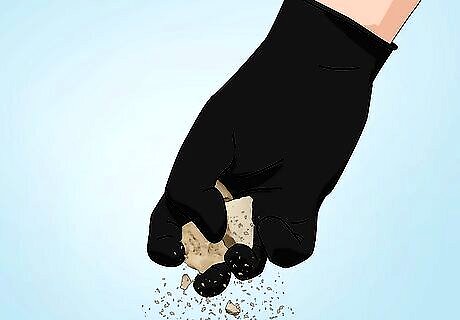
Crumble the baked limestone chunks. If the limestone has been baked for long enough, it should have a dry, crumbly consistency. Put on a pair of work gloves and use your hands to crumble the cooled limestone into a fine powder. The resulting powder is cement, which you can mix with water, sand, and gravel to make concrete. If you need to store some of the crumbled quicklime for later use, store it in an airtight container.
Making Concrete with a Cement Mix
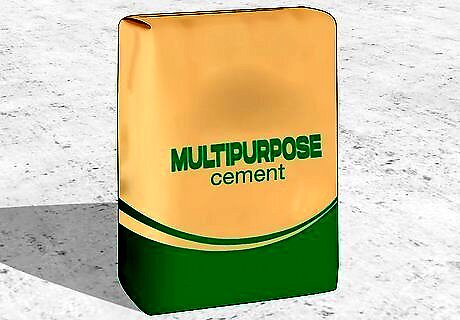
Select the right type of cement. Large hardware stores and home-supply stores (such as Lowe’s or Home Depot) will stock a large variety of cement types. For example, if you’re setting gate posts, purchase an anchoring cement. If you’re laying a patio or a driveway, opt for a fiber reinforced cement. If you are using the cement for a variety of projects or are not familiar with using cement, purchase either a regular (multi-purpose) or fast-setting mix (like Quikrete). Consult the sales staff at the hardware store for additional help selecting a type of cement or concrete.
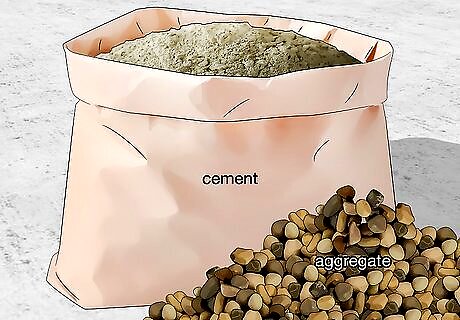
Purchase cement with aggregate if you’re laying thicker concrete. If you are laying a single layer of concrete that will be thicker than ⁄4 inch (1.9 cm)—such as a building foundation or driveway—purchase cement with aggregate mixed in. Aggregate is stones and gravel added to the cement mixture to make it stronger and less likely to crack. If you prefer not to buy cement with aggregate already included, you can also purchase gravel at a hardware store and add this into the aggregate-free cement later.
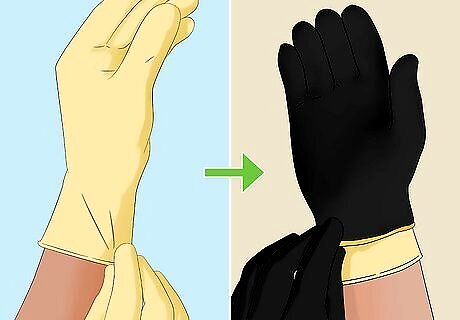
Put on two layers of hand protection. Cement is messy, and it will likely get all over your hands. If cement contacts your skin directly, brush it off immediately. To protect your hands, first put on a pair of latex gloves. Then, over these, put on a pair of sturdy work gloves. To protect your eyes, you should also always wear a pair of safety goggles when working with cement. Since cement will harm your lungs, think about wearing a surgeon’s mask or bandana over your mouth when pouring dry cement.

Cut open the bag of cement and empty the contents in a wheelbarrow. Use the blade of your shovel to stab an opening in the bag near one end. Then grab the cement bag firmly by the other end, and upend it so the powder spills out into the wheelbarrow. If you prefer to use a machine mixer rather than mixing by hand, you’ll pour the opened bag of cement into the machine basin. Avoid shaking the bag as your pour out the cement powder. It’s very dusty, and shaking the bag will fill the air with cement powder.
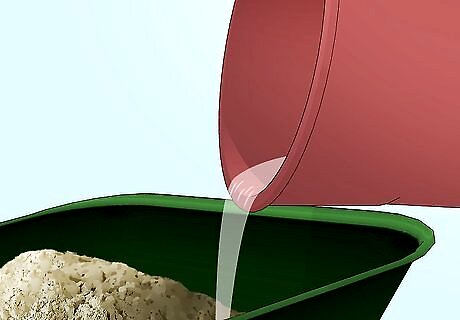
Add water to the cement powder. Using a garden hose, add a reasonable amount of water to the center of the dry cement powder. Start by adding about 1 gallon (3.8 L) of water. It’s best to start out with a smaller amount of water and add more as needed—it’s inconvenient to add a second bag of cement if you add to much water to the first batch. If you’re mixing multiple bags of cement, you’ll quickly get the hang of how much water is necessary. EXPERT TIP Gerber Ortiz-Vega Gerber Ortiz-Vega Masonry Specialist Gerber Ortiz-Vega is a Masonry Specialist and the Founder of GO Masonry LLC, a masonry company based in Northern Virginia. Gerber specializes in providing brick and stone laying services, concrete installations, and masonry repairs. Gerber has over four years of experience running GO Masonry and over ten years of general masonry work experience. He earned a BA in Marketing from the University of Mary Washington in 2017. Gerber Ortiz-Vega Gerber Ortiz-Vega Masonry Specialist Expert Trick: If you're working on a project where you'll have a concrete finish, measure out 3 parts concrete, then add 1 part water. If you're making a concrete foundation for a retaining wall or a post, the concrete can be a little more wet, because the finish won't matter as much.
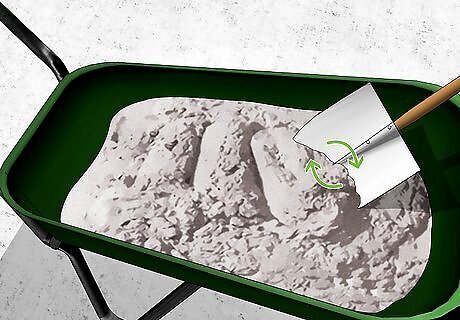
Mix the water into the cement powder. Use your shovel to stir the water into the dry powder. Pull the dry cement mix from the outer edge of the wheelbarrow into the wet center, and stir until there is no dry powder left in the wheelbarrow. Ideally, the cement should be a little runny at this point, about the consistency of thin putty. Stir slowly, so that the water doesn’t slosh over the sides of the wheelbarrow. If you’re using the mixing machine, simply flip the “On” switch and let the machine stir for you.
Add a shovel-full of sand if required. Most fast-setting bags of concrete mix will already contain sand, so you won’t need to add any. If you purchased cement without sand already mixed in, add 3 or 4 shovels-full of sand to the soupy concrete mixture, then stir until the sand has been worked in. The technically correct ratio of mixing cement with sand is 1 part cement, 3 parts sand, and 3 parts water. However, you can customize this ratio as you see fit. For most projects, you won’t need 3 times as much sand as cement. Start with a 1:1 ratio instead. If you’re planning to add aggregate to your concrete mixture, add the aggregate now as well. Add sand and aggregate separately to ensure that each gets fully mixed into the wet concrete.
Making “Survival Cement” From Mud and Grass
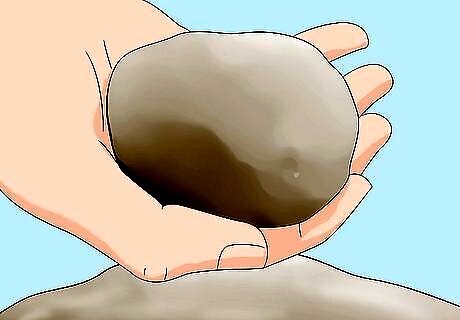
Gather thick, clay-rich mud. If you are located near a river, lake, or other body of water, you can gather mud from its banks. Otherwise, you may need to make your own mud by digging up clay-rich soil and adding water to it. The clay should be a thin consistency so that it will mix well with dry grass. A clay-rich mud or soil will result in a strong, durable cement.

Gather an armload of dry grass. Walk to a nearby field or riverbank and pull up a large armload of old, dead grass. You’ll use this to mix with the mud. Green grass will not work. The grass needs to be dry and hard in order to make suitable survival cement.
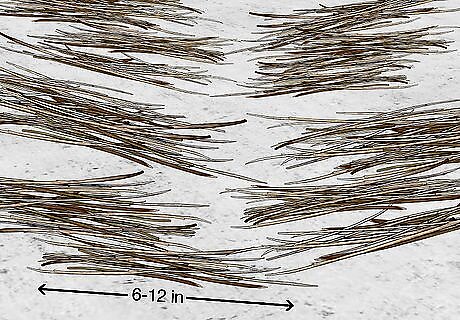
Cut the grass to a usable length. The grass that you’ve harvested will probably be very long, which will prevent it from mixing well with the cement. Solve this problem by using a field knife to cut the grass down into a suitable length. It will be most convenient if you do this on top of a large tarp. For most projects, the grass will work best when cut into sections between 6 inches (15 cm) and 12 inches (30 cm).
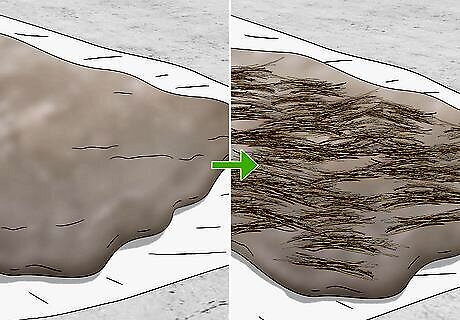
Pour the mud out on the tarp. Do this near the location where you’ve set the cut grass stalks. Once the mud is on the tarp, set about half of the grass on top of the mud.
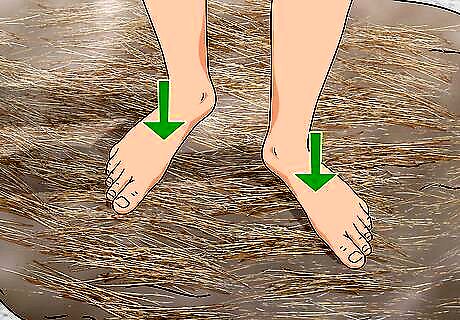
Stomp the mud and grass together. Either wearing shoes that you don’t mind getting muddy, or barefoot, step up and down on top of the mud and grass mixture until the two elements have been fully smashed together. If you don’t want to get your shoes or feet dirty, fold a corner of the tarp on top of the mud and grass and stomp on top of that.
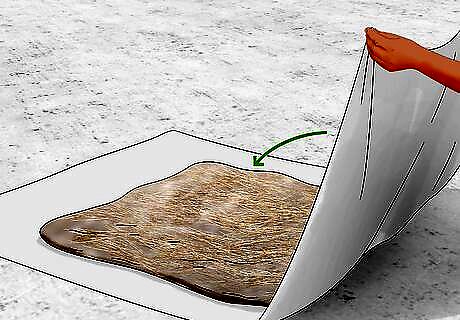
Roll the mud and grass back on itself. At this point, the mud and grass will be smashed into a flat layer. Pick up one edge of the tarp, and lift until the mud/grass mixture folds back over itself. Do this a couple of times, until the mixture is roughly in a round shape.
Add the rest of the grass and stomp again. Place the remaining half of the dry grass stalks on top of the mud and grass mixture. Walk in place on top of the mixture, using the same technique as before. This will force all of the newly-added grass to fully blend with the mud/grass mixture, leaving you with well-blended survival cement. At this point, your survival cement is finished. Begin shaping and working with it immediately, as the mud will dry quickly. You can form your batch of survival cement into a series of bricks, which can be built into a small hut in adverse survival conditions. In non-survival situations, you could use these cement bricks to build a retaining wall or fire pit.




















Comments
0 comment